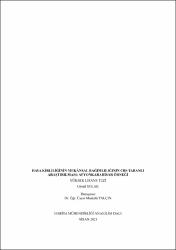| dc.contributor.advisor | Yalçın, Mustafa | |
| dc.contributor.author | Solak, Gönül | |
| dc.date.accessioned | 2021-08-09T08:02:41Z | |
| dc.date.available | 2021-08-09T08:02:41Z | |
| dc.date.issued | 2021 | en_US |
| dc.identifier.uri | https://hdl.handle.net/11630/9031 | |
| dc.description.abstract | Hava kirliliği doğrudan veya dolaylı olarak birçok hastalığa neden olmaktadır. Küresel bir sorun haline gelen hava kirliliğinin nedenlerinin araştırılması ve çözüm önerilerinin hayata geçirilmesi gerekmektedir. Bu çalışmada, hava kirliliğinin mekânsal parametreler ile ilişkisi CBS tabanlı mekânsal istatistiksel yöntemler ile açıklanarak, kirlilik dağılım haritalarının oluşturulması amaçlanmaktadır. Çalışma kapsamında, 2015 yılında Çevre ve Şehircilik Bakanlığı (ÇŞB) tarafından yürütülen proje kapsamında pasif örnekleme yöntemi ile hava kirletici parametrelerinin ölçümü yapılan 36 noktadan Afyonkarahisar ili, Merkez ilçesini kapsayacak 26 nokta seçilmiştir. Hava kirletici parametrelerinden olan kükürt dioksit (SO2) ve azot dioksit (NO2) parametrelerinin tüm mevsimlere ilişkin ölçüm verileri (birer aylık ortalama veriler) kullanılmıştır. Ölçüm noktalarının konum bilgileri, kirletici parametrelerin konsantrasyon değerleri, çalışma alanı içerisinde yer alan binalara ilişkin veriler, mevcut arazi kullanım türleri (yeşil alan, açık alan, sanayi alanları), mahalle bazında ısınma türü yüzdeleri ve yol türlerine ilişkin veriler kullanılarak veri tabanı oluşturulmuştur. Kirlilik parametrelerinin konsantrasyon düzeyinin ölçüldüğü her bir nokta için 500’er metre çapında alan (tampon bölge) oluşturulmuştur. Tampon bölgelerde bağımlı ve bağımsız değişkenlerin arasında anlamlı bir ilişki olup olmadığının ve bağımsız değişkenlerin hava kirliliğine etkisinin belirlenmesinde keşifsel regresyon analizi kullanılmıştır. Tek değişkenli regresyon analizi yapılarak kirletici parametreleri ile çevresel faktörler arasındaki ilişki açıklanmaya çalışılmıştır. Mekânsal otokorelasyon testleri ile kümelenmeler araştırılmış ve Ters Mesafe Ağırlıklı Enterpolasyon (IDW) yöntemi kullanılarak kirlilik dağılım haritaları oluşturulmuştur. Tüm mevsimler için oluşturulan kirlilik dağılım haritalarında çalışma alanı içerisinde yer alan mahalleler tek tek incelenmiştir. Kirletici parametrelerinin mekânsal bağımlılığı açıklanmaya çalışılmıştır. Elde edilen sonuçlara göre, SO2 parametresinin kirlilik seviyesi, bina taban alanı, kat adedi ile doğru, açık alan büyüklüğü ile ters orantılıdır ve kirliliğin en yüksek olduğu mevsim kış mevsimidir. NO2 parametresinin kirlilik seviyesi ise, ana yol uzunlukları ve yeşil alan ile doğru orantılı olarak tespit edilmiştir. Ayrıca NO2 kirletici konsantrasyonunun en yüksek olduğu mevsim yaz mevsimi olarak bulunmuştur. | en_US |
| dc.description.abstract | Air pollution causes many diseases directly or indirectly. The causes of air pollution, which is a global problem, should be investigated and solution suggestions carried out. In this study, the relationship of air pollution with spatial parameters was explained with GIS-based spatial statistical methods and pollution distribution maps were created. Within the scope of the study, 26 points covering the central district of Afyonkarahisar were selected from 36 points where air pollutant parameters were measured by passive sampling method within the scope of the project carried out by the Ministry of Environment and Urbanization (MoEU) in 2015. Measurement data (monthly averages) for all seasons of sulfur dioxide (SO2) and nitrogen dioxide (NO2), which are among the air pollutant parameters, were used. A database was created using the location information of the measurement stations, the concentration values of the pollutant parameters, the building data in the study area, the types of land use (green, open or industrial areas), the heating type information on the neighborhood and the road types. An area (buffer zone) with a diameter of 500 meters was created for each station where the concentration level of the pollution parameters was measured. Exploratory Regression Analysis was used to determine whether there is a significant relationship between dependent and independent variables in the buffer zones and the effect of independent variables on air pollution. By using Single Regression Analysis method, the relationship between pollutant parameters and environmental factors was tried to be explained. Clusters were investigated with spatial autocorrelation tests and pollution distribution maps were created using the Inverse Distance Weighted Interpolation method. In the pollution distribution maps created for all seasons, the neighborhoods within the study area were examined separately and the spatial dependence of the pollutant parameters was tried to be explained. According to the results, SO2 pollution is highest in winter season. In addition, as the building floor area and the number of floors increase, the SO2 pollution level increases, while the structureless area increases, the SO2 pollution level decreases. As the main road lengths and green area size increase, the NO2 pollution level increases. Aslo the season with the highest concentration of NO2 pollutants was found to be summer. | en_US |
| dc.language.iso | tur | en_US |
| dc.publisher | Fen Bilimleri Enstitüsü | en_US |
| dc.rights | info:eu-repo/semantics/openAccess | en_US |
| dc.subject | CBS | en_US |
| dc.subject | Mekansal Regresyon Analizi | en_US |
| dc.subject | Mekansal Otokorelasyon | en_US |
| dc.subject | Ters Mesafe Ağırlıklı Enterpolasyon | en_US |
| dc.subject | Hava Kirliliği, Kirleticiler | en_US |
| dc.title | Hava kirliliğinin mekânsal bağımlılığının cbs tabanlı araştırılması: Afyonkarahisar örneği | en_US |
| dc.title.alternative | Gis-based investigation of the spatial dependency of air pollution: the example of afyonkarahisar | en_US |
| dc.type | masterThesis | en_US |
| dc.department | Enstitüler, Fen Bilimleri Enstitüsü, Harita Mühendisliği Ana Bilim Dalı | en_US |
| dc.identifier.startpage | 1 | en_US |
| dc.identifier.endpage | 137 | en_US |
| dc.relation.publicationcategory | Tez | en_US |
| dc.contributor.institutionauthor | Solak, Gönül | |



















